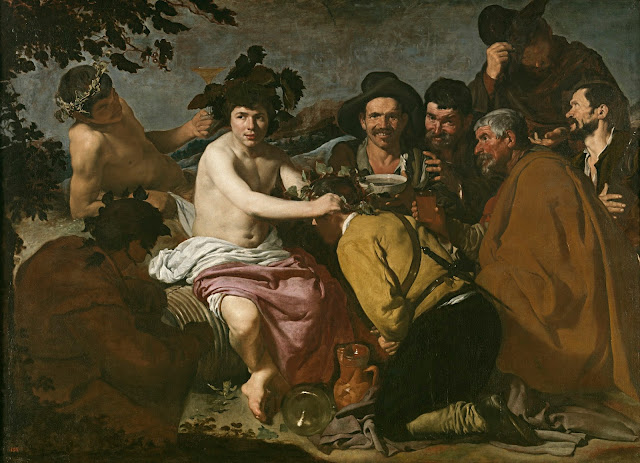 |
| Diego Velázquez The Surrender of Breda 1635 Prado |
The Prado in Madrid makes available exceptionally careful and beautiful photographs of selected paintings from the collection, including eight of the ten by Velázquez seen here. Concerning the venerable sublimity of the Prado there can be no finer authority than Louisine Havemeyer, the American art collector who scrutinized the museum several times at the end of the 19th century –
"We settled in our hotel in Spain; we began at the beginning, and a good one it was, the Prado. Mr. Havemeyer always maintained that after the Spanish War we should have demanded the Prado as an indemnity instead of taking over the Philippines, and he lived long enough to know that he was right. We did not need the Philippines, and the Prado would have been inestimable to us as a young nation, young in the art sense."
 |
| Diego Velázquez The Triumph of Bacchus 1628-29 Prado |
"The gallery was a revelation of art; I think its contents the greatest and most creditable monument to the art-loving Charles V and his descendants, the many Philips. Is there any other gallery where you see so many masterpieces, and from so many different schools?" The work of Velázquez alone, Mrs. Havemeyer informs her reader, "would make it a gallery unique in the world."
 |
| Diego Velázquez The Spinners c. 1655-60 Prado |
 |
| Diego Velázquez The Needlewoman 1640s National Gallery of Art (U.S.) |
 |
| Diego Velázquez The God Mars 1638 Prado |
 |
| Diego Velázquez Mercury & Argus 1659 Prado |
 |
| Diego Velázquez Vulcan's Forge 1630 Prado |
 |
| Diego Velázquez St. Anthony Abbot & St. Paul the Hermit 1633 Prado |
 |
| Diego Velázquez Adoration of the Magi 1619 Prado |
 |
| Diego Velázquez Supper at Emmaus c. 1622-23 Metropolitan Museum of Art, New York |
– quotations are from Sixteen to Sixty, the art-collecting memoirs of Louisine W. Havemeyer, first published in 1930.